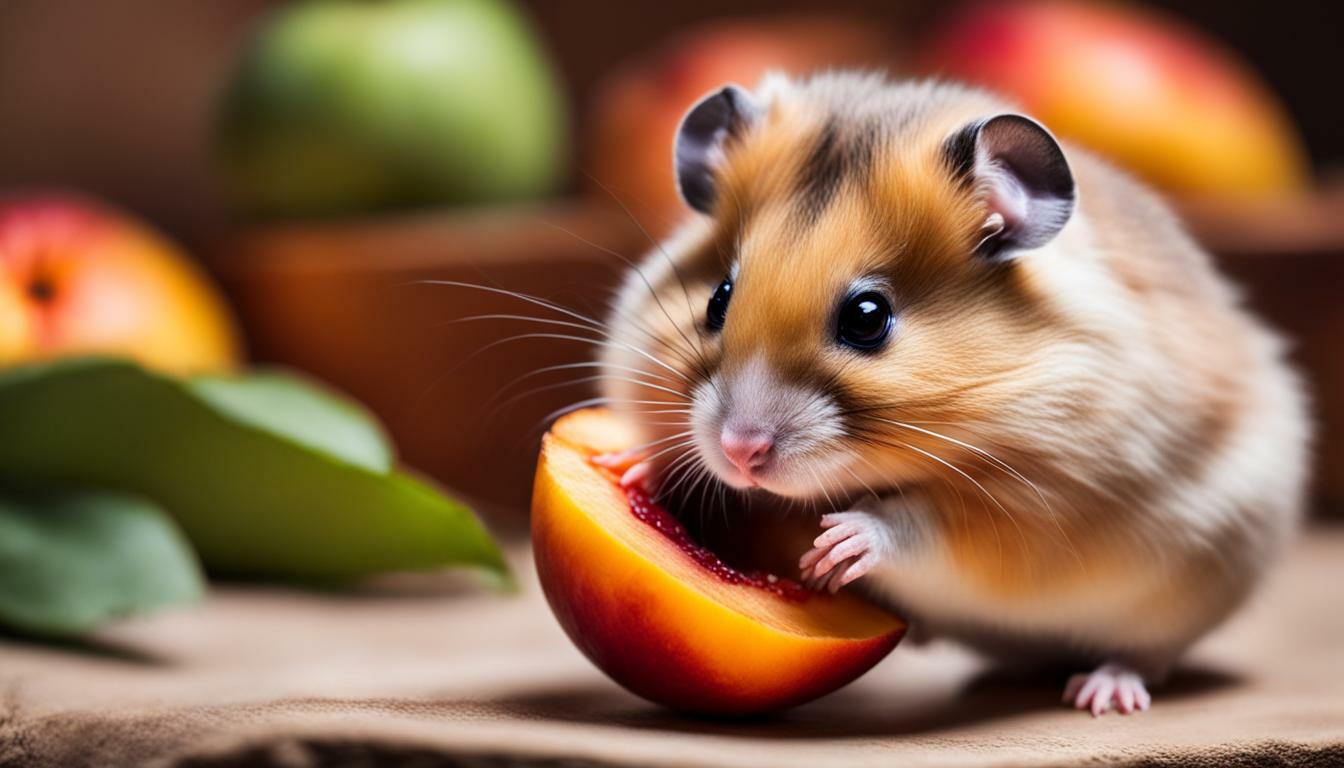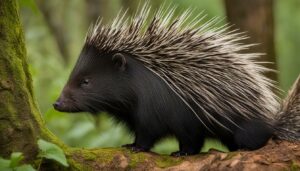If you’re wondering whether nectarines are a safe and healthy treat for your hamster, you’ve come to the right place. Hamsters can indeed enjoy nectarines in moderation, as they are safe for them to consume. These sweet and juicy fruits can be a tasty addition to your hamster’s diet, but it’s important to keep a few things in mind.
Key Takeaways:
- Nectarines can be fed to hamsters in moderation.
- Feed small pieces of nectarine, no more than twice a week.
- Remove the pits before offering nectarines to hamsters.
- Be mindful of the high sugar content in nectarines.
- Ensure a balanced diet for your hamster by incorporating a variety of safe fruits and vegetables.
Understanding Hamster Diets
Before we dive into the specifics of feeding nectarines to your hamster, let’s first understand the importance of a well-rounded diet for these little furry friends. Just like humans, hamsters require a balanced diet to maintain their overall health and well-being. A proper hamster diet consists of a combination of essential nutrients, including proteins, carbohydrates, fats, vitamins, and minerals.
When it comes to incorporating fruits into a hamster’s diet, it’s essential to choose the right ones that provide both nutritional value and a tasty treat. Fruits can be a great source of vitamins and minerals for hamsters, but they should be given in moderation due to their high sugar content. As with any food, it’s crucial to offer fruits as a healthy treat rather than the main part of their diet.
Some hamster-friendly fruits include apples, strawberries, blueberries, and of course, nectarines. These fruits provide a range of nutrients and antioxidants that can support your hamster’s immune system and overall health. However, it’s important to note that fruits should only make up a small portion of their diet. The main diet should consist of high-quality hamster pellets that contain all the necessary nutrients.
| Fruit | Feeding Frequency | Suggested Portion Size |
|---|---|---|
| Apples | 1-2 times per week | Small slices without seeds |
| Strawberries | 2-3 times per week | One small strawberry |
| Blueberries | 2-3 times per week | A few blueberries |
| Nectarines | 1-2 times per week | Small pieces without pits |
Remember, while fruits can be a healthy addition to your hamster’s diet, it’s crucial to maintain a balanced approach. A diet that is too high in sugar can lead to obesity, digestive issues, and other health problems. Always introduce new foods gradually and monitor your hamster’s reaction. If you notice any signs of discomfort or digestive upset, it’s best to consult with a veterinarian specialized in small animals.
The Nutritional Value of Nectarines for Hamsters
Nectarines are not only delicious, but they also offer several essential nutrients that can support your hamster’s well-being. These sweet fruits are packed with vitamins and minerals that can contribute to a balanced diet for your furry friend.
One of the key nutrients found in nectarines is vitamin C, which is essential for the overall health of hamsters. Vitamin C helps boost their immune system and promotes the production of collagen, which is important for maintaining healthy skin and fur. Nectarines also contain vitamin A, which is essential for good eyesight and reproductive health.
In addition to vitamins, nectarines provide hamsters with important minerals such as potassium and fiber. Potassium plays a vital role in maintaining healthy heart function and regulating blood pressure. Meanwhile, the fiber found in nectarines aids in digestion and helps prevent constipation, a common issue in hamsters.
When serving nectarines to your hamster, it’s important to keep portion sizes in mind. While nectarines can be a nutritious addition to their diet, it’s best to offer small pieces no more than twice a week. This ensures that your furry friend receives the benefits of the fruit without consuming excessive sugar, which can lead to weight gain and other health problems.
Table: Nutritional Composition of Nectarines
| Nutrients | Amount per 100g |
|---|---|
| Calories | 44 |
| Carbohydrates | 11g |
| Fiber | 2g |
| Protein | 1g |
| Fat | 0.3g |
| Vitamin C | 5.4mg |
| Vitamin A | 322IU |
| Potassium | 201mg |
To ensure the safety of your hamster, always remove the pits before offering nectarines. The pits can pose a choking hazard and contain small amounts of cyanide, which can be toxic to hamsters if ingested.
Remember to monitor your hamster’s reaction when introducing new foods, including nectarines. Watch for any signs of allergies or digestive issues. If your hamster experiences any adverse reactions, consult a veterinarian for further guidance.
Overall, nectarines can be a tasty and nutritious treat for your hamster when given in moderation. By incorporating them into a balanced diet alongside other safe fruits and vegetables, you can ensure that your furry friend receives the necessary nutrients for a happy and healthy life.
Moderation Is Key
While nectarines can be a tasty treat for your hamster, it’s crucial to remember that moderation is key when it comes to incorporating them into their diet. These sweet and juicy fruits provide a delightful addition to your hamster’s menu, but their high sugar content means they should be given in small portions and infrequently. Feeding your hamster a few small pieces of nectarine, no more than twice a week, is recommended to prevent overconsumption of sugar.
When feeding nectarines to your hamster, make sure to remove the pits beforehand. The pits can pose a choking hazard or cause intestinal blockages if ingested. By removing the pits, you can prevent any potential harm to your furry friend and ensure they can safely enjoy their treat.
Remember that nectarines should not be the sole focus of your hamster’s diet. It’s important to provide a balanced and varied diet that includes a mix of fruits, vegetables, and other hamster-appropriate foods. While nectarines can be a tasty addition, they should be offered alongside other nutritious options to ensure your hamster receives a well-rounded diet.
| Nectarine Feeding Guidelines: |
|---|
| Offer small pieces of nectarine, no more than twice a week |
| Remove pits before feeding nectarines to your hamster |
| Incorporate nectarines as part of a balanced diet |
Pit Removal Is Necessary
Before giving your hamster a bite of nectarine, make sure to remove the pits to ensure their safety. Hamsters should never be given nectarines with the pits intact as they pose a choking hazard. The pits are hard and can be difficult for hamsters to chew and digest. If ingested, the pits can cause obstruction in the digestive system, leading to potential health issues for your furry friend.
To safely prepare nectarines for your hamster, cut the fruit into small, bite-sized pieces, ensuring that all pits are completely removed. This will help prevent any accidental ingestion of the pits and protect your hamster from potential harm. Additionally, it’s important to remember that hamsters have sensitive digestive systems, so introducing new foods, including nectarines, should be done gradually and in small quantities.
Table: Possible Health Risks of Ingesting Nectarine Pits
| Health Risks | Prevention |
|---|---|
| Choking | Always remove pits before feeding nectarines to your hamster |
| Obstruction | Carefully check each piece of nectarine for any remaining pits |
| Dental Damage | Avoid giving your hamster hard food items to prevent dental issues |
By taking the necessary precautions and removing the pits from nectarines, you can ensure that your hamster can safely enjoy this sweet and juicy treat. Remember to introduce new foods gradually, monitor your hamster’s reaction, and always prioritize their health and well-being when it comes to their diet. With proper care and moderation, nectarines can be a delightful addition to your hamster’s diet and provide them with essential vitamins and minerals.
Safe Fruit Alternatives for Hamsters
If you’re looking to diversify your hamster’s diet, there are several other fruits and vegetables that you can offer them as healthy alternatives to nectarines. These options can provide a variety of nutrients and flavors to keep your furry friend happy and satisfied. Here are some safe fruit and vegetable options for hamsters:
- Apples: Slice a small piece of apple without the seeds or core, and offer it as a tasty treat.
- Strawberries: These juicy berries are rich in vitamin C and can be served whole or cut into small pieces.
- Blueberries: Packed with antioxidants, blueberries are a great choice for a nutritious snack.
- Carrots: Crunchy and low in sugar, carrots are a popular vegetable option for hamsters.
- Broccoli: This green veggie is packed with vitamins and minerals, making it a healthy addition to their diet.
Remember to introduce new foods gradually and observe your hamster’s reaction. Some hamsters may have preferences or sensitivities to certain fruits or vegetables, so it’s important to monitor their behavior and adjust their diet accordingly. Always wash fruits and vegetables thoroughly before feeding them to your hamster to remove any pesticide residue.
Offering a Balanced Diet
Incorporating a variety of fruits and vegetables into your hamster’s diet is essential for their overall health and well-being. These foods should be offered as occasional treats and should not replace their main diet of hamster pellets and fresh water. It’s important to provide a balanced diet to ensure they receive all the necessary nutrients.
| Fruit/Vegetable | Serving Size | Frequency |
|---|---|---|
| Apples | Small slice without seeds or core | 1-2 times per week |
| Strawberries | 1-2 berries or small pieces | 1-2 times per week |
| Blueberries | A few berries | 1-2 times per week |
| Carrots | 1-2 baby carrots or small pieces | 1-2 times per week |
| Broccoli | Small floret or piece | 1-2 times per week |
By offering a variety of fruits and vegetables in moderation, you can keep your hamster’s diet interesting and provide them with the necessary nutrients for a happy and healthy life.
Monitoring Your Hamster’s Reaction
As with any new food, it’s essential to closely monitor your hamster’s response when introducing nectarines into their diet. While nectarines can be a tasty and nutritious treat for hamsters, every hamster is unique, and individual reactions may vary. Paying attention to your furry friend’s behavior and any physical changes is crucial to ensure their health and well-being.
Signs to Watch Out For:
- Changes in appetite: Keep an eye on whether your hamster shows increased or decreased interest in food after consuming nectarines.
- Digestive issues: Diarrhea, constipation, or any abnormal stool consistency should be noted and addressed promptly.
- Lethargy or unusual behavior: If your hamster appears unusually tired or exhibits any strange behavior after consuming nectarines, it’s important to take note and consult with a veterinarian if necessary.
Note: Remember that moderation is key when it comes to feeding nectarines to your hamster. Overfeeding or introducing too many new foods at once can lead to digestive issues or upset their delicate balance. Always consult a veterinarian if you have any concerns or questions about your hamster’s diet or health.
| Safe Fruits for Hamsters | Portion Size | Frequency |
|---|---|---|
| Apples | Small pieces, no seeds or core | 1-2 times a week |
| Blueberries | 1-2 berries | 1-2 times a week |
| Strawberries | Small pieces, remove the stem and leaves | 1-2 times a week |
It’s always a good idea to offer a variety of fruits to your hamster to ensure a well-rounded nutritional intake. Remember to introduce new fruits gradually, one at a time, and in small portions. This will allow you to observe any potential reactions and ensure your hamster’s digestive system adjusts well.
Summary: Nectarines can be safely incorporated into your hamster’s diet as a tasty and nutritious treat. However, it’s important to monitor their reaction, feed in moderation, and remove the pits before offering them. By following these guidelines, you can provide your hamster with a balanced and enjoyable diet that includes safe fruits.
Incorporating Nectarines into Your Hamster’s Diet
Ready to treat your hamster to some juicy nectarines? Here are a few simple and enjoyable ways to include this fruit in their diet.
1. Small and Sweet: Cut a small piece of nectarine into tiny cubes or thin slices. Remember to remove the pit before offering it to your hamster. Place the nectarines in their food bowl as a delightful and nutritious snack.
2. Frozen Fun: Hamsters love frozen treats, especially during hot summer months. Try freezing small slices of nectarines and offering them to your furry friend. Not only will this provide a refreshing treat, but it will also help to soothe their gums.
3. Nectarine Mash: Mash a small portion of ripe nectarine into a smooth consistency and place it on a spoon or your finger for your hamster to enjoy. This can be a great opportunity for bonding and allowing your hamster to lick the mashed fruit from your hand.
Remember, moderation is key when introducing nectarines into your hamster’s diet. Stick to small portions, no more than twice a week, to avoid overfeeding and maintain a balanced diet. Nectarines are high in sugar, so it’s important to keep their consumption in check. Always monitor your hamster’s reaction to new foods and consult a veterinarian if you have any concerns about their diet.
| Nectarine Serving Ideas | Description |
|---|---|
| Nectarine Skewers | Thread small pieces of nectarine onto a wooden skewer for your hamster to nibble on. |
| Nectarine Salad | Mix small chunks of nectarine with other hamster-safe fruits for a colorful and nutritious salad. |
| Nectarine Puree | Blend ripe nectarines to create a smooth puree that can be added to your hamster’s regular food or as a standalone treat. |
With these tips, you can safely incorporate nectarines into your hamster’s diet, providing them with a tasty and healthy snack option. Remember to always prioritize your hamster’s well-being and consult a veterinarian if you have any doubts or questions about their dietary needs.
Conclusion
In conclusion, nectarines can indeed be a safe and tasty addition to your hamster’s diet, as long as they are given in moderation and pit-free. Remember to prioritize a balanced diet and observe your hamster’s reaction to ensure their health and happiness.
Nectarines are a sweet and juicy treat that can provide variety and nutrition to your hamster’s meals. However, due to their high sugar content, it is important to feed them in small portions, no more than twice a week. This will help prevent any potential digestive issues or weight problems.
When offering nectarines to your hamster, always remember to remove the pits. The pits of nectarines can be a choking hazard and may contain toxic compounds. To prepare the fruit, simply cut it into small, bite-sized pieces and remove all the pits before offering it to your furry friend.
As with any new food, it’s crucial to monitor your hamster’s reaction when introducing nectarines into their diet. Look out for any signs of discomfort or adverse reactions, such as diarrhea or changes in behavior. If you notice any negative effects, it’s best to discontinue feeding nectarines to your hamster and consult a veterinarian.
Overall, nectarines can be a tasty and nutritious addition to a hamster’s diet if given in the appropriate portions. Remember to balance their diet with other fruits, vegetables, and high-quality hamster food. By providing a diverse and well-rounded diet, you can ensure that your hamster remains happy, healthy, and satisfied.
FAQ
Can hamsters safely eat nectarines?
Yes, hamsters can eat nectarines in moderation.
Are nectarines a healthy treat for hamsters?
Nectarines can be a tasty and nutritious addition to a hamster’s diet.
How often should I feed my hamster nectarines?
It is recommended to feed hamsters small pieces of nectarine no more than twice a week.
Should I remove the pits from nectarines before feeding them to my hamster?
Yes, it is crucial to remove the pits before offering nectarines to hamsters.
What other fruits can I give my hamster besides nectarines?
Other safe fruit options for hamsters include apples, bananas, and strawberries.
How can I incorporate nectarines into my hamster’s diet?
You can serve small pieces of nectarines as treats or mix them with your hamster’s regular food.
What should I look out for when introducing nectarines to my hamster?
Watch for any signs of adverse reactions such as diarrhea or changes in behavior.
Can hamsters eat nectarines every day?
No, it is important to feed nectarines to hamsters in moderation to prevent health issues.
Is a balanced diet important for hamsters?
Yes, a balanced diet is crucial for a hamster’s overall health and well-being.




